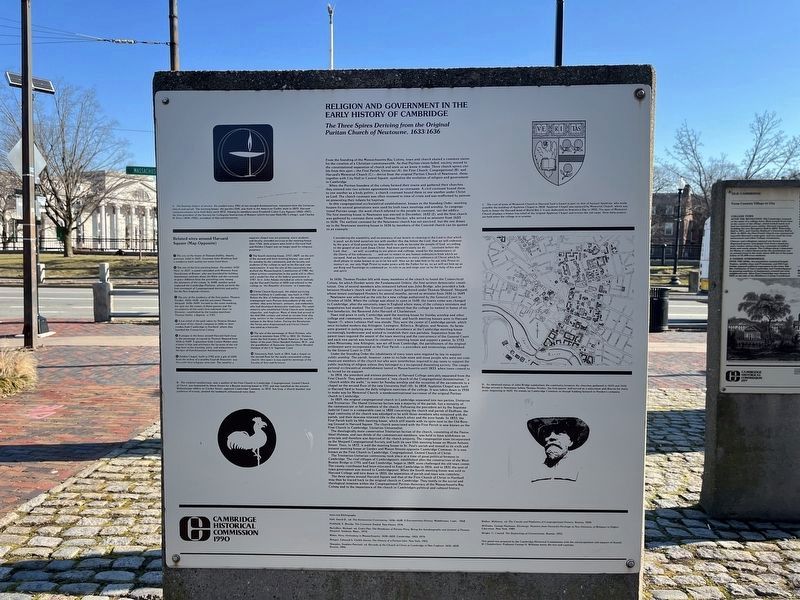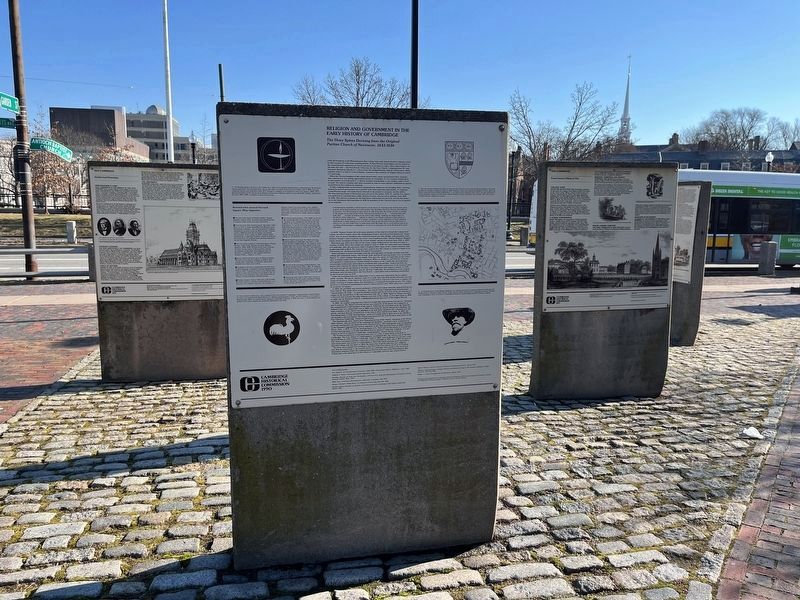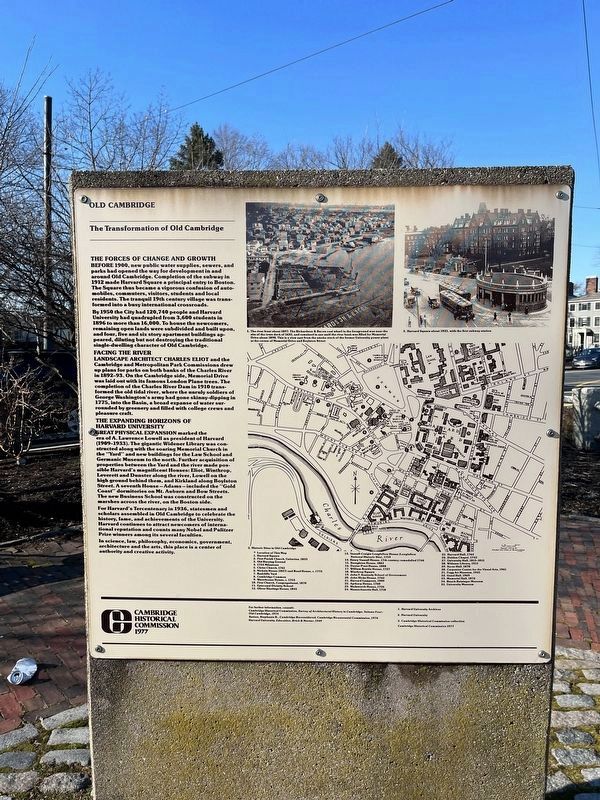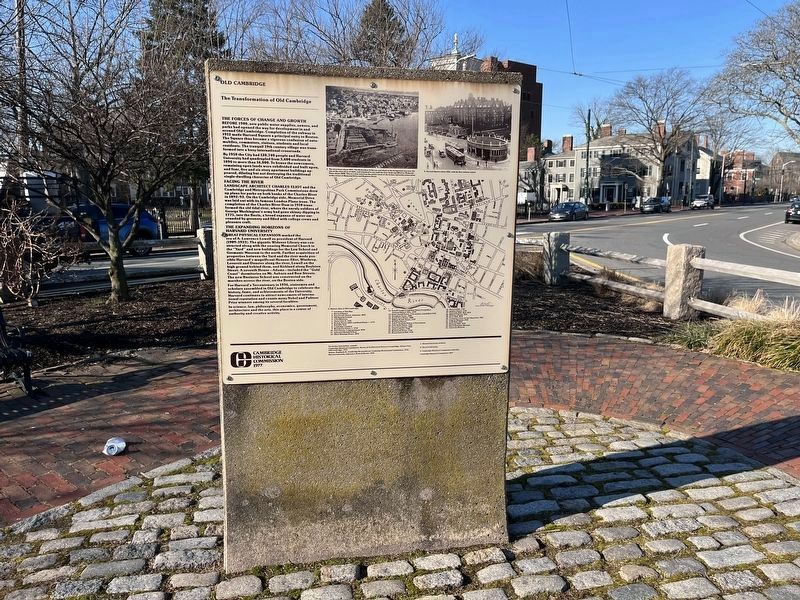Neighborhood Nine in Cambridge in Middlesex County, Massachusetts — The American Northeast (New England)
Old Cambridge / Religion and Government in the Early History of Cambridge
Old Cambridge
The Transformation of Old Cambridge
The Forces of Change and Growth
Before 1900, new public water supplies, sewers, and parks had opened the way for development in and around old Cambridge. Completion of the subway in 1912 made Harvard Square a principal entry into Boston. The Square thus became a vigorous confusion of automobiles, commuters, visitors, students and local residents. The tranquil 19th century village was transformed into a busy international crossroads.
By 1950 the City had 120,740 people and Harvard University had quadrupled from 3,600 students in 1896 to more than 16,000. To house the newcomers, remaining open lands were subdivided and built upon, and four, five and six story apartment buildings appeared diluting but not destroying the traditional single-dwelling character of Old Cambridge.
Facing the River
Landscape architect Charles Eliot and the Cambridge and Metropolitan Park Commissions drew up plans for parks on both banks of the Charles River in 1892-93. On the Cambridge side, Memorial Drive was laid out with its famous London Plane trees. The completion of the Charles River Dam in 1910 transformed the old tidal river, where the unruly soldiers of George Washington's army had gone skinny-dipping in 1775, into the Basin, a broad expanse of water surrounded by greenery and filled with college crews and pleasure craft.
The Expanding Horizons of Harvard University
Great physical expansion marked the era of A. Lawrence Lowell as president of Harvard (1909-1933). The gigantic Widener library was constructed along with the soaring Memorial Church in the "Yard" and new buildings for the Law School and Germanic Museum to the north. Further acquisition of properties between the Yard and the river made possible Harvard's magnificent Houses: Eliot, Winthrop, Leverett and Dunster along the river, Lowell on the high ground behind them, and Kirkland along Boylston Street. A seventh House — Adams — included the "Gold Coast" dormitories on Mt. Auburn and Bow Streets. The new Business School was constructed on the marshes across the river, on the Boston side.
For Harvard's Tercentenary in 1936, statesmen and scholars assembled in Old Cambridge to celebrate the history, fame, and achievements of the University. Harvard continues to attract newcomers of international reputation and counts many Nobel and Pulitzer Prize winners among its several faculties.
In science, law, philosophy, economics, government, architecture and the arts, this place is a center of authority and creative activity.
Religious and Government in the Early History of Cambridge
The Three Spires

By Devry Becker Jones (CC0), January 28, 2023
2. Religion and Government in the Early History of Cambridge side of the marker
From the founding of the Massachusetts Bay Colony, town and church shared a common vision for the creation of a Christian commonwealth. As that Puritan vision faded, society moved to the constitutional separation of church and state as we know it today. Three church spires visible from this spot — the First Parish, Unitarian (A), the First Church, Congregational (B), and Harvard's Memorial Church (C) — derive from the original Puritan Church of Newtowne; these, together with City Hall in Central Square, symbolize the evolution of religion and government in Cambridge.
When the Puritan founders of the colony formed their towns and gathered their churches, they entered into two solemn agreements known as covenants. A civil covenant bound them to one another as a body politic; a church covenant bound them to one another under Christ as Lord. The church covenant was often renewed in time of crisis and was reaffirmed by parents on presenting their infants for baptism.
In this congregational ecclesiastical establishment, known as the Standing Order, meeting houses for several generations were used for both town meetings and worship. In congregational Puritan usage, the word church referred to the people in covenant, not in the edifice. The first meeting house in Newtowne was
Considering the instability and inconstancy of our hearts in cleaving to the Lord in that which is good, we do bind ourselves one with another this day before the Lord, that we will endeavor by the grace of God assisting us, henceforth to walk as become the people of God, according to the gospel of our Lord Jesus Christ. And more particularly we do … covenant before the Lord, that … we will, according to our places and callings, stand for the maintenance of the liberty of his ordinances … and not to return to any human ordinances from which we escape. And we further covenant to subject ourselves to every ordinance of Christ which he shall please to make known to us to be his will. Also we do take him to be our only Priest to instruct us, our only High Priest to make peace with the Father for us; so we will set him up as our King and Sovereign to command us, to rule in us and reign over us by the help of his word and spirit.
In 1636, Thomas Hooker left with many members of the church to found the Connecticut Colony,

By Devry Becker Jones (CC0), January 28, 2023
4. Religion and Government in the Early History of Cambridge side of the marker
Newtowne was selected as the site for a new college authorized by the General Court in October of 1636. When the college was about to open in 1638, the town's name was changed to Cambridge, after the university town in England where many of the colony's ministers and magistrates had studied. the General Court ordered that the college be named in honor of its first benefactor, the Reverend John Harvard of Charlestown.
Town and gown in early Cambridge used the meeting house for Sunday worship and other college and community events. The second, third, and fourth meeting houses were in Harvard Square (7), where Lehman Hall now stands. They were the center of Cambridge parish, which once included modern-day Arlington, Lexington, Billerica, Brighton, and Newton. As farms were granted in outlying areas, settlers found attendance at the Cambridge meeting house increasingly burdensome and wished to establish their own parishes. Separation from the parent town required the assent of the town meeting and the concurrence of the General Court, and each new parish was bound to construct a meeting house and support a pastor. In 1733, when Menotomy, now Arlington, was set off from Cambridge, the parishioners of the original settlement were incorporated as the First Parish — a procedure and terminology established by the General Court in 1718.
Under the Standing order the inhabitants of every town were required by law to support public worship. The parish, however, came to include more and more people who were not communicant members of the church but who were nonetheless required to pay taxes to support the public teaching of religion unless they belonged to a recognized dissenting society. The congregational ecclesiastical establishment lasted in Massachusetts until 1833, when taxes ceased to be levied for its support.
In 1814, the president and sixteen professors of Harvard amicably separated from the First Church. They gathered in covenant a "new church of the Congregational denomination," a "church within the walls," to meet for Sunday worship and the reception of the sacraments in a chapel on the second floor of the new University Hall (10). In 1858, Appleton Chapel was built in Harvard Yard to house the daily religious exercises of the college. It was taken down in 1930 to make way for Memorial Church, a nondenominational successor of the original Puritan church in Cambridge.
In 1829, the original congregational church in Cambridge separated into two parties, Unitarian and Trinitarian. The liberal Unitarian faction was a majority of the parish, but a minority of the communicant or full members of the church. Following the precedent set by the Supreme Judicial Court in a comparable case in 1820 concerning the church and parish of Dedham, the legal continuity of the church was adjudged to be with those members who remained with the parish, and their deacons retained title to the church silver and the poor funds. In 1833, the First Parish built its fifth meeting house, which still stands with its spire next to the Old Burying Ground in Harvard Square. the church associated with the First Parish is now known as the First Church in Cambridge, Unitarian Universalist.
The theologically more conservative Trinitarian faction of the church, consisting of the Pastor, Abiel Holmes, and two-thirds of the communicant members, was held to have withdrawn on principle and therefore was deprived of the church property. The congregational soon incorporated as the Shepard Congregational Society and built its own fifth meeting house on Mount Auburn Street. Then, in 1872, it sold the meeting house to St. Paul's parish and moved to its sixth and present meeting house at Garden and Mason Streets opposite Cambridge Common. It is now known as the First Church in Cambridge, Congregational, United Church of Christ.
The Trinitarian-Unitarian controversy took place at a time of great political ferment in Cambridge. The rival villages of Cambridgeport, established after the construction of the West Boston Bridge in 1793, and East Cambridge, begun in 1809, soon challenged the old town center. The county courthouse had been relocated to East Cambridge in 1816, and in 1831 the seat of town government was moved to Cambridgeport. When the fourth meeting house was sold to Harvard College and torn down in 1833, the separation of parish and town was complete.
The three spires around Harvard Square and that of the First Church of Christ in Hartford may thus be traced back to the original church in Cambridge. They testify to the social and theological tensions within the Congregational Puritan theocracy of the Massachusetts Bay Colony and to the importance of the church in Cambridge's political and cultural history.
Related sites around Harvard Square (Map Opposite)
❶ The site of the house of Thomas Dudley, deputy governor, built in 1631. Governor John Winthrop had a residence built nearby but never lived there.
❷ The site of the first meeting house, December 1632. Here, in 1637, a synod contended with Mistress Anne Hutchinson of Boston, who was banished for holding Antinomian opinions about the Bible and the covenant of grace different from the prevailing view among the ministers of the colony. In 1648, another synod endorsed the Cambridge Platform, which set forth the first statement of Congregational doctrine and policy for the New England colonies.
❸ The site of the residence of the first pastor, Thomas Hooker, 1633-1636, and his successor Thomas Shepard, 1636-1649. Incised on the stone marking the spot are the names of these pastors and the incumbents of Harvard's first endowed chair (in Divinity), established by the London merchant Thomas Hollis, a Baptist, in 1721.
❹ A bas-relief of the path taken by Thomas Hooker and most of his church company in 1636 on their exodus from Cambridge to Hartford, where they founded the Connecticut Colony.
❺ A plaque in the fence around Harvard Yale close to the parsonage occupied by Thomas Shepard from 1636 to 1649. A quotation from Cotton Mather pays tribute to him and attributes the location of the college here to his learning, piety, and stalwartness in the face of Hutchinsonian Antinomianism.
❻ Holden Chapel, built in 1742 with a gift of £400 from the widow of a wealthy English Dissenter, was Harvard's first religious structure. The need for a separate chapel was not pressing, since students and faculty attended services at the meeting house. After 1766, daily prayers were held in Harvard Hall, and Holden Chapel was no longer used for religious purposes.
❼ The fourth meeting house, 1757-1829, on the site of the second and third meeting house, was used for worship by the community and the faculty and students of the college as well as for Harvard commencements. It was the site of the convention that drafted the Massachusetts Constitution of 1780, the oldest written constitution in the world still in effect and a model for that of the federal government in 1787. In it John Adams included an article embodying the Harvard Charter of 1650 and referred to the college as "the Republic of Letters" in Cambridge.
❽ Christ Church Episcopal, the oldest surviving church building in Cambridge, was built in 1760. Before the War of Independence, the majority of the townspeople were Puritan descendants of the early settlers; they were farmers, artisans, and tradesmen who had developed democratic traditions. The small minority who established Christ Church were loyalist, oligarchic, and Anglican. Many of them arrived in the mid-18th century and relied on income from shipping, service in the colonial administration, or plantations in the West Indies. During the Revolution, the Tories were dispossessed and Christ Church was used as a barracks.
❾ The site of the parsonage of Abiel Holmes, who served as minister from 1792 to 1831. Dr. Holmes wrote the first history of North America; he was the father of the poet Oliver Wendell Holmes, M.D., and the grandfather of Associate Justice Oliver Wendell Holmes of the U.S. Supreme Court.
❿ University Hall, built in 1814, had a chapel on the second floor for the newly covenanted college church: this space is now used for meetings of the Faculty of Arts and Sciences.
Erected 1977 by Cambridge Historical Commission.
Topics and series. This historical marker is listed in these topic lists: Churches & Religion • Colonial Era • Education • Settlements & Settlers. In addition, it is included in the Unitarian Universalism (UUism) series list. A significant historical month for this entry is October 1636.
Location. 42° 22.528′ N, 71° 7.173′ W. Marker is in Cambridge, Massachusetts, in Middlesex County. It is in Neighborhood Nine. Marker is at the intersection of Massachusetts Avenue (Massachusetts Route 2A) and Garden Street, on the right when traveling south on Massachusetts Avenue. Touch for map. Marker is in this post office area: Cambridge MA 02138, United States of America. Touch for directions.
Other nearby markers. At least 8 other markers are within walking distance of this marker. Old Cambridge (here, next to this marker); a different marker also named Old Cambridge (here, next to this marker); History of Cambridge (here, next to this marker); Route of William Dawes (here, next to this marker); George Washington (within shouting distance of this marker); Cambridge Common (within shouting distance of this marker); Revolutionary War Memorial (within shouting distance of this marker); An Gorta Mór - The Great Hunger (within shouting distance of this marker). Touch for a list and map of all markers in Cambridge.
Credits. This page was last revised on February 1, 2023. It was originally submitted on February 1, 2023, by Devry Becker Jones of Washington, District of Columbia. This page has been viewed 85 times since then and 30 times this year. Photos: 1, 2, 3, 4. submitted on February 1, 2023, by Devry Becker Jones of Washington, District of Columbia.

